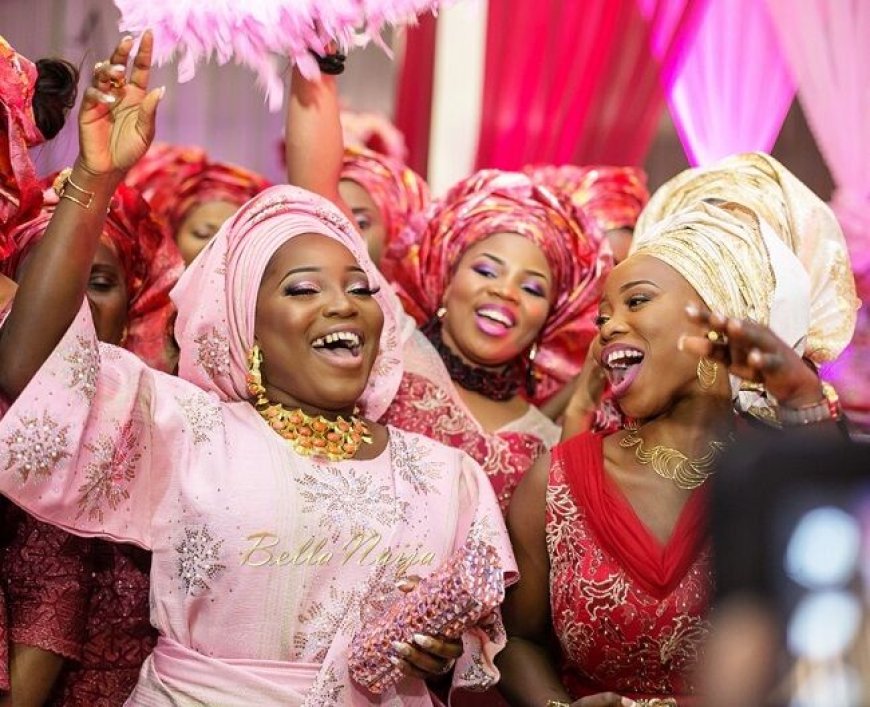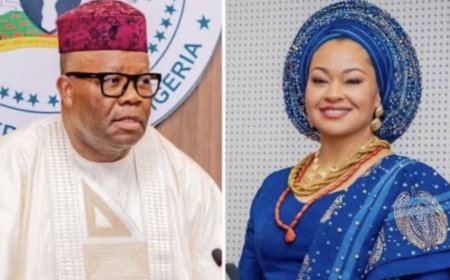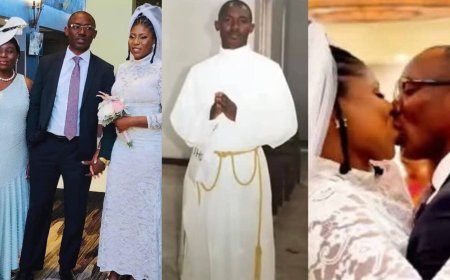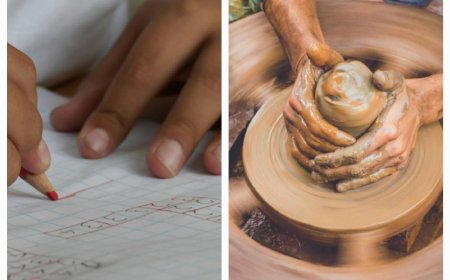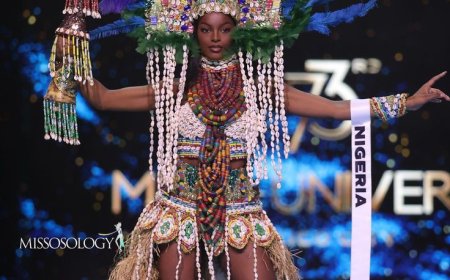Owanbẹ, the popular word used mostly to describe lavish parties among the Yorubas, was coined from a slang in the 60s. It has always been believed that a beautiful Yoruba woman's accessories were incomplete without the Ilẹkẹ (waist beads). Yoruba men mostly sought to have a feel of these beads around the women's waists when they danced with them at the parties. When a man felt the beads with his hand placed around the woman's waist while dancing, he would look in the direction of his fellow men and they would ask in unison, “Ṣowanbẹ?” (Is it there?), he would reply “Owanbẹ” (It's there). This is how ‘Owanbẹ’ became a slang to describe parties attended by beautiful and sociable women, till it covered all Yoruba social events to this
day.
This article paints vivid illustrations to explain the art and culture of Yoruba celebrations. It is divided into two acts: The era of Owanbẹ in the 1960s and the modern sophistication of Owanbẹ.
Act 1: The Era of Owanbẹ in 1960s
Setting the Stage
Narrator: Welcome, everyone, to this special occasion. You are about to have a delightsome experience such as you've never had. With your permission, let's embark down the memory lane of the vibrant history of Owanbẹ starting from the 1960s. Could we all join in the chorus with the theme of this event?
Everyone: Owanbẹ
Narrator: I see you are all in the spirit. Let the party begin!
Scene 1: Chief Owónikókó's 50th Birthday Party
Narrator: The beautiful scenery reveals the celebratory atmosphere of Chief Owónikóko's 50th birthday party in the heart of Iseyin. The ensemble features four giant, brightly coloured canopies erected on the expansive space in his home. Each canopy is covered in vibrant hues made from rich aṣọ òkè fabric The decorations are top-notch, with the seating arrangements,comprising four rows of table, each with five chairs. The tables are draped with cover cloths made from aṣọ òkè, and fresh flowers, arranged in vases, are set in the middle of each table.
Narrator: The brightly coloured canopies not only enhancethe visual spectacle but also reflect the vibrant spirit of Yoruba culture. The origin of aṣọ òkè can be traced back to the 15th century, when it was created by the Yoruba people of Nigeria. The town of Iseyin in Oyo State, Nigeria, is widely believed to be the birthplace of aṣọ òkè, home to a large number of weavers, and the cloth has been produced there for centuries. It signifies cultural pride and heritage, reflecting the rich history of Yoruba culture. Also, using it as decoration exudes the elegance and authenticity of the celebration.
Additionally, the incorporation of fresh flowers into the decorations enhances their aesthetic appeal and brings a sense of harmony and order to the festivities. The combination of these elements woven together produces a vibrant outfit in all shades of its cultural beauty.
Scene 2 : The arrival of guests
Narrator: As the guests arrive, the melodious music fills the air. People laugh and chat as they find their seats. Leading the performance is none other than the renowned Fuji singer, Alhaji Sikiru Ayinde Barrister, accompanied by his talented crew members, “Supreme Fuji Commanders” ready to entertain the audience.
Narrator: Fuji is a genre of Nigerian music that evolved from traditional Yoruba music styles, particularly Sakara, Apala, and the Islamic Ajisari/Were music performed during Ramadan. It was created and popularized by Alhaji Sikiru Ayinde Barrister. His energetic performances and unique style of Fuji music made him a popular choice for events such as weddings, birthdays, and other celebrations.
Scene 3: Welcoming the Celebrant and Guests
Alagá: May I have your attention everyone? It's time to welcome the celebrant, Chief Owónikókó!
Narrator: Chief Owónikókó appears in a royal blue flowing agbada, taking one step at a time, in rhythm to the music while supporting each hem of his agbada with his hands, keeping it from falling off. Agbada is a traditional Yoruba attire, historically worn by Yoruba royalty and nobility, signifying social status, wealth and power.
Alagá: Thank you, Supreme Fuji Commanders, for that beautiful performance. Without wasting
much time, I'd like to welcome the Owónikókó family as well to the table reserved for them, close to his seat. Next on the list are Báṣọrun Àjànàkú, and his lovely wife, ÁárẹTíjání. I kindly request everyone to rise and welcome the King's representative,Òtúnba Àrèmú to the high table .
Everyone: With a loud ovation, and a resounding round of applause,Òtúnba Àrèmú is ushered to his seat.
Alagá: The next on the agenda is a short performance by the youths of this great town, Iseyin. Enjoy!
Scene 4: The Dance Appearance & Item 7
Narrator: The dancers appear on stage with the men dressed in dànṣíkí shirts paired with matching sókótó. The women, too, grace the dance floor, looking stunning in their Ìró and bùbá with gèlè. The beaded earrings and necklace complement their outfits; the dancers swayed their waists gently to the rhythm of the bata drum. With their beautifully rehearsed dance steps, they steal the spotlight. The audience is stunned for words.
Narrator: Meanwhile, servers had begun serving the guests with food and drinks. The array of food options include Amala and Ewedu soup, the star of the day, Pounded Yam, popularly known as Iyan,with Egusi Soup Efo riro is not left out of the menu. Pepper soup, Moi Moi served with Rice and Stew rich with all sorts of assorted meats, delights the guests with its rich flavour, taste and tantalizing aroma.
Alagá: I hear the clattering of plates and munching sounds of delicious delicacies. That's a good one! Fill your stomachs to the brim, as there's so much to go round and take home as well. Right now, I'd like to welcome Chief Owónikóko to give a short speech and vote of thanks.
Everyone: Few manage to clap. Others struggle to tear apart the pieces of meat in their mouths,
squinting one eye while making sure the soup doesn't splatter or stain their outfits.
Chief Owónikóko: Today is a joyous one for me, and I'm grateful to witness it in good health and wellness. Seeing the faces of people who have come to celebrate with me, fills my heart with joy. Thank you, for gracing this occasion with your presence. Rejoicing will not cease in our habitations.
Everyone: Àmín(Amen)
Narrator: The musicians take over, singing eulogies of the celebrant and inviting people to dance, some moving forward to their arena. It was a splendid evening, filled with celebration. As the final notes of the last song fade into the night, the era of Owanbẹ marked by its lavish gatherings and joyful celebrations, gently draws to a close. Times have changed, but the spirit of Owanbẹ is still alive, breathing its rhythm to the ears of the people.
Act 2 : Modern Owanbẹ
Setting the Stage
Narrator: The passage of time transcends to a modern era with sophistication served on the platter of celebrations. There's a mental preparation that goes on in the mind before the cost and budgeting is transferred on paper. It's not enough to desire celebrating any occasion; physical, mental, financial and emotional readiness is required.
Narrator: Let's take a peek at the retirement party of Mrs. Arìnolá left the civil service after serving as a teacher for more than 25 years.
Scene 1: The Celebration
Narrator: The grand celebration takes place in a large event hall, decorated in modern Nigerian
styles with colorful fabrics, elaborate table settings, and a stage for performances. There are designated areas for food, music, and dancing.
Fúnkẹ (Her daughter): She appears to be supervising the event, making sure everything is in order. The hall is adorned with flowers and exquisite designs.
Narrator: Guests start arriving, dressed in their various aso ebi styles. The hall is alive with music from the DJ who plays a couple of hip-hop music. The guests greet Mrs. Arìnolá offering her gifts and well wishes as they find their seats.
Narrator: Hip-hop music was started in Nigeria by a group called The Sugarhill Gang. Modern Owanbẹ parties began incorporating hip hop music into their playlists, alongside traditional highlife, juju and Fuji music. The hip hop culture's influence extended beyond music to fashion and lifestyle, with attendees at Owanbẹ parties adopting hip-hop inspired attire and accessories.
Scene 2: Tributes about Mrs. Arìnolá
MC: I formally welcome everyone to this beautiful occasion. I'd like everyone to rise as Mrs. Arìnolá dances in, accompanied by the DJ playing her favourite song.
MC: Thank you all. It's time to listen to speeches and tributes from family, friends and former colleagues. Please, signify if you want to say a thing or two about her.
Narrator: Few people raised their hands and were given time to do so.
Fúnkẹ: My mother is a loving woman, humble and peaceful. She wants the best for everyone around her and has poured her heart into teaching and impacting others. It's my prayer for her today that she will continue to remain relevant in life.
Mr. Adékúnlé: I've known Mrs. Arìnolá since we started working as colleagues. She is a woman
of integrity, wisdom and humble to the core. It's been a privilege to meet such a beautiful soul. I wish you a hearty congratulations on your retirement from service.
Mrs. George: I'm Arìnolá's older sister. Since childhood, she had always expressed her desire to be a teacher and seeing her retiring today gladdens my heart. There are no lies mentioned by people who have described her. I pray that she will always have reasons to celebrate.
Everyone: Amen.
MC: They've all said lovely things about her but because of time we wouldn't be able to
accommodate more testimonies.
Scene 3: Cutting the cake
Narrator: A grand, multiered cake is presented. The cake-cutting ceremony is a new feature of the modern Owanbẹ in contrast to the 1960s era where there was no such thing.
MC: I have the honour of inviting Mrs. Arìnolá to cut the cake. Can I get a round of applause as she comes?
Everyone: (Claps)
Narrator: After the cake is cut, a toast is made with wine glasses celebrating Mrs. Arìnolá legacy and future. The dance floor is open to everyone. The DJ plays contemporary Nigerian songs as guests dance, laugh and take photos.
Narrator: The curtain is drawn, signifying the end of a wonderful retirement party displayed by the Yoruba people.
In conclusion, the journey of Owanbẹ celebrations from the 1960s to today showcases the vibrant blend of tradition and modernity in Nigerian culture. Originally, Owanbẹ parties were colorful, traditional gatherings where Yoruba customs, music, and attire took center stage. These events featured aṣọ òkè fabrics, traditional dishes, and indigenous music like Fuji, creating a lively and culturally rich atmosphere.
Today, Owanbẹ has evolved, integrating current components while preserving its traditional roots.Contemporary Nigerian celebrations now feature hip hop music alongside classic highlife and Fuji music. Modern Owanbẹ events are known for their ornamentation, trendsetting attire inspired by hip hop culture, and a diverse music mix that keeps the party lively and inclusive.Yet, despite these changes, the essence of Owanbẹ remains the same. These celebrations continue to honour community, heritage, and joy. They are more than just social gatherings; they are a testament to the enduring and flexible nature of Yoruba culture.
